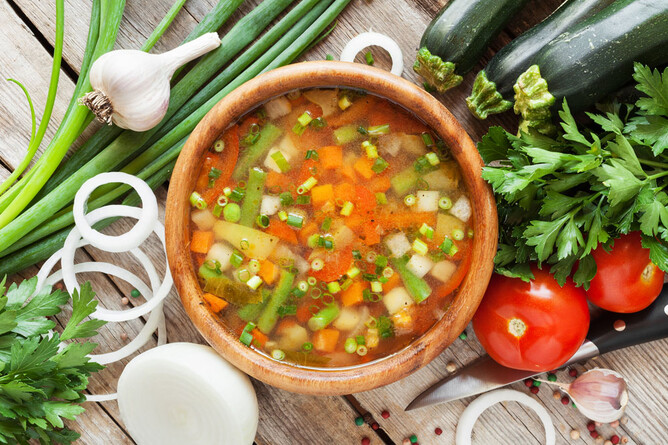On-page SEO: The secret ingredient to boosting your Google ranking
Search engine optimisation (SEO) is complex. Google, by far the world’s most popular search engine, takes into account no less than 200 hundred factors when assigning rankings to websites in response to a search query. But there’s one factor that is often ignored but always important: on-page content.
On-page SEO: one dish, two hundred ingredients
Think of SEO like a delicious, rich soup. A seafood bisque or minestrone, just like mama used to make. And in this soup is over 200 hundred ingredients. Add a little of this, and it’s sweeter; add a little of that, and it’s thicker. But, with a little care and attention, you’ll get a tasty dish i.e., a website that ranks highly in the search engine results.
But what if, after all that “cooking”, your site still doesn’t rank well? You’ve got title tags, description tags, inbound links but, still...barely a blip on Google’s radar. Your soup is missing something; it needs a little something more...But what?
This is a common problem. When you work closely with as many clients as we do at Rocketspark, trying to cook up the best website possible, you start to notice certain trends. I’ve learned what works and what doesn’t when it comes to search rankings. In this blog post, I’m going to share a few of these trade secrets with you.
Content: The secret ingredient
What really matters in SEO, what will really add some zip n’ zing to your soup is nailing the content that appears on the page. Note: I’m not talking about metadata. Metadata, those little bits of code running in the background of a webpage that webcrawlers read such as title tags, description tags etc. still matter—but you can’t rely on these alone to do all the SEO heavy-lifting. Over the past few years, Google has been releasing cuddly-critter-themed updates to its algorithm (i.e., the formula it uses to decide rankings) and, ever since, it has been rewarding pages that have excellent content, not just excellent metadata. So I’m talking about the actual words on-screen that people visiting a website can read. That is the secret ingredient.
It’s like throwing a chilli in the pot. Without optimised content, your page will be flat and lifeless, failing to rank well. But pop a few of those keywords in there and—bam!—you’ve just kicked your ranking up a notch (or ten). There’s a delicate balancing act to be performed here. There has been a trend in recent years towards image-oriented design. More photos, less words. But, according to web usability experts NNG, “a balanced approach works best for most sites”. This is an important principle to take onboard because, while a purely visual website might look gorgeous, ditching the text means your capacity for targeting keywords—and, thus, for ranking well—is significantly compromised.
Tips for your content: Getting the recipe right
Include your keywords in your text.
Stating the obvious? Perhaps, but, believe me, I’ve seen plenty of people fail to do this. So let’s be crystal clear here: make sure the target keywords actually appear on the page. This is rule number one. What are keywords? They’re the words (and phrases) that your target demographic are likely to be typing into search engines when looking for your kind of product or service. Example: the keywords for a beautician’s website will be “beauty salon”, “makeup artist”, “pedicure” etc. Said beautician must include those sorts of words in the website’s text. Simple but essential.
Target each page to a particular purpose.
A properly-optimised webpage, according to SEO authority Moz, “targets a single searcher intent”. In other words, you don’t need cram all conceivable keywords into every page on your site. Instead, identify the specific goal of each page and gear the keywords to that end. This means that users may come to your site through pages other than the homepage, because your secondary pages have focused on a more specific set of keywords. No biggie. If they like the landing page, they’ll usually check out the rest of your site.
Let the topic determine the length.
One of the nice things about writing for the web is the length of your content is limited only by the interest levels of your readers. If they want to read a lot, you can give them a lot. And SEO researchers have made the (surprising) discovery that longer content usually scores higher rankings in search results. But how much is too much? Simply let the topic determine the length. If it’s a simple idea, quickly conveyed, keep it brief. If it requires time, write something longer. What you do not want to do, however, is keyword stuff your piece, where you cram an unnatural number of keywords into it. Google will penalise you for that tactic. But this isn’t anything to lose sleep over. Just write naturally and your page will be in the clear.
Put keywords in the body text.
Keywords that appear in headers (i.e., page titles and sub-section headings) pack more of an SEO punch than keywords that appear in the main body text—but not by as much as you might think. Yes, it’s a good idea to put keywords in your headers, but it’s also important to include them in the main paragraphs of your writing. And, because body text is longer, you can fit more in.
Optimise your homepage too.
The temptation to ditch words is strongest on the homepage. It’s your shop window and you want to make a strong impression—so why not do it with big, bold images and zero text? Because, in my experience, a new keyword-optimised homepage will enjoy high rankings much faster than an images-only homepage (when that kind of website will rank is anybody’s guess!). It goes back to the balancing act we talked about in the previous section. You need images to draw people in and make them feel something, but you need copy to ensure your website will be found in Google in the first place. For further reading see our blog on the value of longer pages on your website.
Include keywords on buttons.
A lot of SEO boils down to links, elements like text or images that will take you to another webpage or website when clicked. Buttons are essentially zhooshed up links to other pages on your site, and that’s good for SEO. But it pays to make sure that the keywords of a page appear in some form on the buttons that link to it.
Optimise in minutes: Keep the cooking time short
When it comes to SEO, the old codger from the Mainland Cheese ads’ adage rings true: “Good things take time”. It takes time to create quality content that will rank well. Even once completed, it takes time to see the results in search engines. But, unlike some so-called “15-minute meals”, optimising your pages is one of the few SEO methods that can be cooked up pretty quickly.
True, writing the content itself is time consuming. Of course, you have to do that anyway, regardless how SEO-savvy (or not) you are (and we have some solid strategies for writing your website copy too). But optimising pages that have already been written doesn’t take long at all. Just identify your keywords for the page and find ways to naturally work them into your existing copy without dramatically altering the content.
Conclusion: Souped-up SEO
Back in the internet’s Wild West days—which wasn’t too long ago—SEO often involved gaming the system. Finding loopholes and sneaky ways to exploit them was, for some people, what SEO was all about. Like serving up Cup-a-Soup and calling it gourmet.
Times have changed. According to SEO expert Eric Ward, “it's gotten harder to get crappy content to rank high.” And that’s a good thing. It means better search results for all of us. But it also means that the need for quality content—well-written website copy that appeals to both humans and search engine “robots”—is more important now than ever before.
So focus on the basics: quality content. You can easily, and quickly, add a flavour kick to your Google-friendly gumbo:
- Include your keywords in your text.
- Target each page to a particular purpose.
- Let the topic determine the length.
- Put keywords in the body text.
- Optimise your homepage too.
- Include keywords on buttons.
So, how’s your SEO? Bit bland? Throw a chilli in the pot! Bon appetit.






